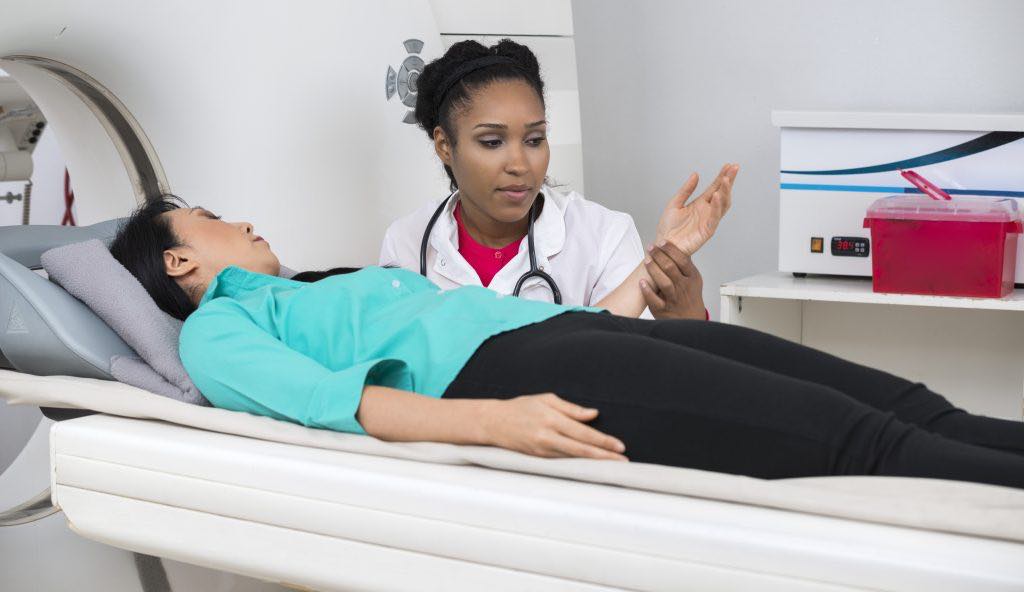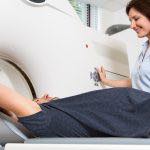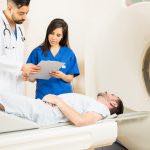A computed tomography (CT) scan is a diagnostic imaging test used to examine the body’s inner organs and tissues. During a CT scan, the x-ray machine takes cross-sectional images of the inside of the body. A radiologist can combine these images to create a three-dimensional picture of your internal structures.
A CT scan can be used to gain insight into the condition of your soft tissues, organs, blood vessels, and bones. Because this scan takes a series of images, it gives physicians a clearer view of these structures than a normal x-ray. This scan can be used to diagnose and monitor certain cancers and diseases, as well as the effects of trauma and other disorders.
During your CT scan, you will lay still on a narrow table while the machine rotates around you and takes images. You should be able to return to your normal activities immediately after the scan. However, if you have a CT scan with contrast, you may be asked to wait at the imaging facility for a short time after your exam to make sure that there are no adverse reactions to the contrast material.
Contrast material is a special dye used in some CT scans to give a clearer image of certain internal tissues, such as blood vessels and intestines. This dye can be taken orally, with an injection, or by enema. Side effects of a CT scan with contrast are rare. However, your doctor will probably tell you to drink plenty of fluids after the scan to assist your kidneys in removing the dye from your body.
Below, learn about the most common reasons for a CT scan and why your doctor may recommend each one.
Reasons for a CT scan of the abdomen
Abdominal CT scans are used to gain insight into undiagnosed pain, injury, and disease in the organs and structures of your abdominal cavity. Additionally, an abdominal CT scan can be used to examine your organs, intestines, and colon. Common reasons for a CT scan of the abdomen are monitoring and diagnosing the following conditions:
- Internal infections and abscesses
- Cancer in the liver, kidneys, and pancreas
- Abdominal pain
- Bowel diseases, including pancreatitis, cirrhosis of the liver, ulcerative colitis, and Crohn’s disease
- Trauma to organs in the abdominal cavity
- Abdominal aortic aneurysms
- Pulmonary embolisms
One of the other reasons for a CT scan of the abdomen is detecting cancers in the chest and abdomen because the resulting images give physicians insight into a tumor’s size, exact location, and interaction with surrounding tissue.
An abdominal CT scan may also be used to assist in certain medical procedures. A physician may use the results of a scan to guide biopsies and abscess drainages. The imaging test can also be used to plan for and evaluate cancer treatments and organ surgeries.
Reasons for a CT scan of the pelvis
A pelvic CT scan is similar to an abdominal CT scan, but it is used to examine the pelvic organs such as the bladder, lymph nodes, hip bones, and reproductive organs. Common reasons for a CT scan of the pelvis are evaluating and diagnosing:
- Tumors and abscesses
- Undiagnosed pelvic pain
- Certain types of cancers
- Kidney stones
- Unexplained infertility
- Trauma to the pelvic bones and organs
Like an abdominal CT scan, this imaging test can also help guide physicians during biopsies and other medical procedures. It is also used when planning cancer treatments and major surgeries.
Reasons for a CT scan of the head
In your physician has recommended a cranial CT scan, also called a brain scan, it’s because they need detailed images of the inside of your head. These images can include your brain, skull, sinuses, and eye sockets.
Common reasons for a CT scan of the head include monitoring and diagnosing:
- Brain aneurysms or hemorrhaging in the brain
- Swelling, infections, tumors, or atrophy in the brain tissue
- The effects of a stroke
- Abnormal fluid in the skull
- Abnormal blood vessel activity
- Birth defects
- Injury to the face, brain, or skull
Your physician may recommend a cranial CT scan to diagnose the cause of:
- Unexplained fainting or headaches
- Seizures
- Loss of hearing or vision
- Sudden speech difficulty or behavioral and cognitive changes
Cranial CT scans can also be used to guide other medical procedures, such as biopsies.
Reasons for a CT angiography
A CT angiography is used to gain insight into the workings of your blood vessels and tissues. If you’re getting a CT angiography, you will probably be administered a contrast material, either orally or intravenously, before the procedure. Contrast dyes are generally safe drugs that are used to make certain internal structures appear more clearly on x-ray images.
This imaging test can be used to examine organs and blood vessels in any part of the body for injury, blockages, and other abnormalities. Additionally, a CT angiography can help physicians prepare the best course of action for upcoming surgeries. It can also be used after major surgeries to detect any aneurysms and disease, as well as evaluate the success of stent placement.
How much should you pay for your CT scan?
No matter the reason your physician recommends a CT scan, it can be a valuable diagnostic tool. Don’t let worry about the cost of a CT scan keep you from scheduling your test. New Choice Health has compiled cost data for CT scans in healthcare facilities across the United States. The cost of your CT scan will vary depending on the reason for the scan, where you choose to have the scan done, and whether you have health insurance. Use New Choice Health’s cost comparison tool to find the best price for a CT scan in your area.







